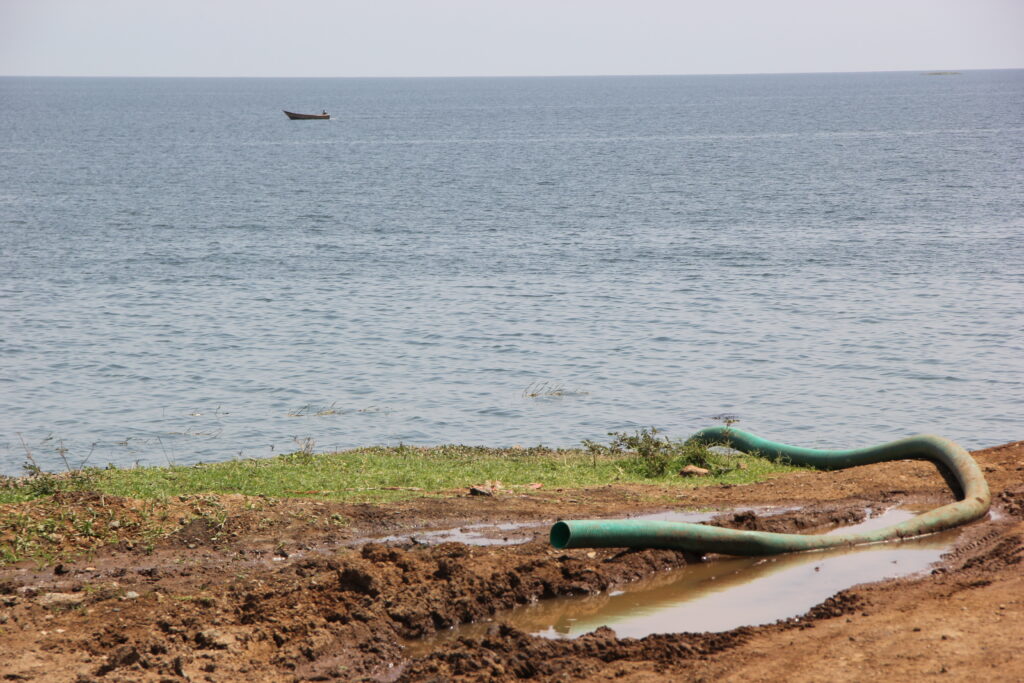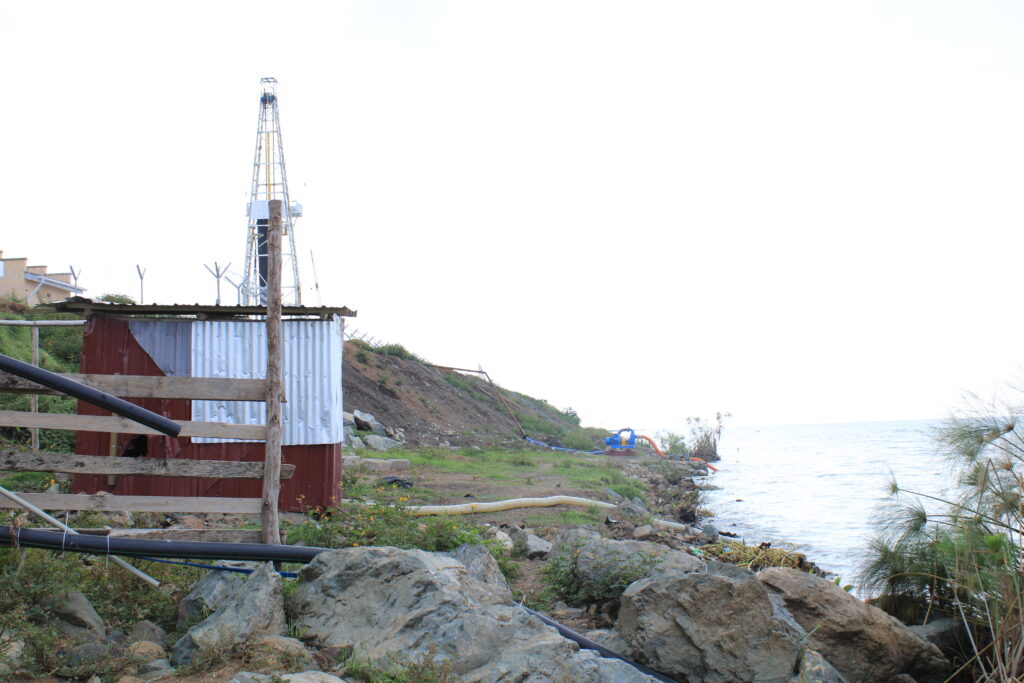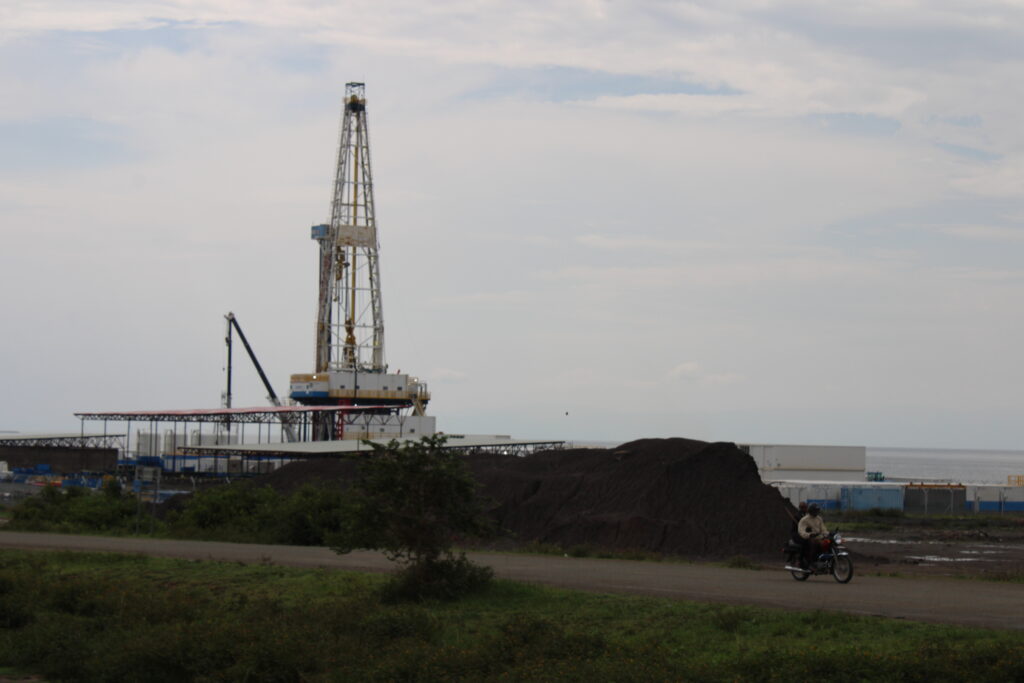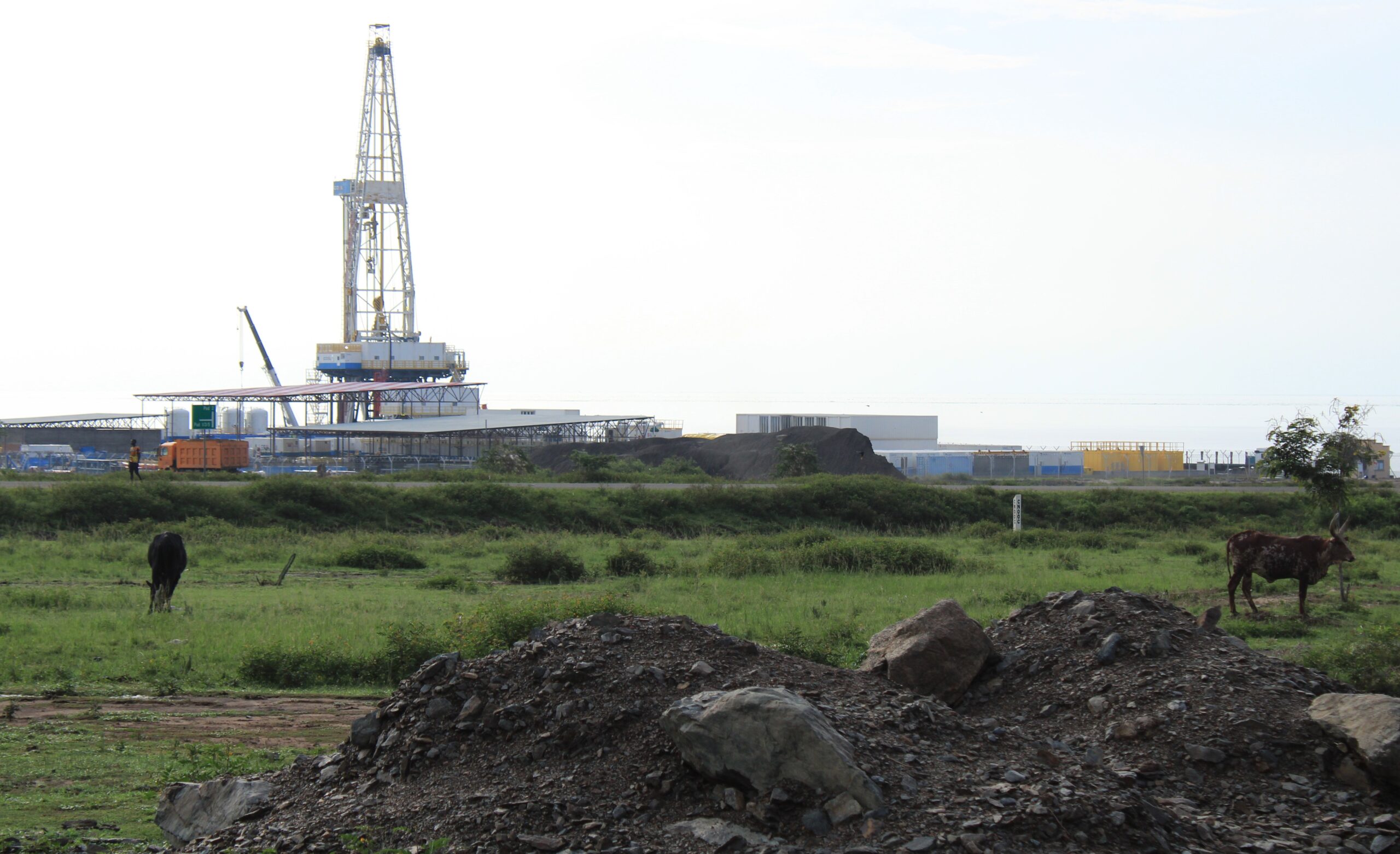As Uganda races to end over a decade’s wait to pump out its first oil by 2025, the country is facing the puzzle of extracting the resource from the complex and ecologically sensitive, Kingfisher Development Area (KFDA) whilst protecting the environment.
The China National Offshore Oil Corporation (CNOOC) Uganda Limited operated KDFA is sandwiched between the winding ridges of the Western Rift valley and the calm blue waters of Lake Albert.
It is the second biggest oil production project after Tilenga with an anticipated production capacity of 40,000 barrels per day (bpd) when production commences.
On a normal sunny day, the expanse adjacent to KFDA is visibly bleak, barren and defeated.
There, it lies with scattered short trees and shrubs helplessly witnessing the grassy plain being encroached on to pave way for access roads, campsites, and oil production facilities under the cover of ubiquitous dust from soil excavation.
The blue of Lake Albert on the other side dances on still but experts worry that this may change soon because oil extraction here is to be done offshore with both vertical and horizontal drilling.
There exists the imminent scare of spills and concerns of discharge of effluent into water and land, among others.

Lake Albert is Uganda’s second largest freshwater lake which is a major component of the Nile Basin catchment at the centre of community livelihoods of nearly two million people in the country.
It is also a transnational water body tied up with the fate and interests of six countries-Uganda, Democratic Republic of Congo (DRC), South Sudan, Sudan, Ethiopia and Egypt.
The lake and the Albertine Graben itself are listed world heritage sites, subject to UNESCO supervision.
Replete here are fish breeding areas, wetlands, cultural and natural sacred sites, mountains, valleys, settlements and rare birds such as the Kingfisher- after which the field was named.
It is here that CNOOC Uganda Limited has planned to set up a Central Processing Facility (CPF) for oil from 31 wells to be drilled on four well pads.
There will be 16 kilometres of flow lines and a 55 kilometre feeder pipeline from the CPF in Buhuka village, Kyangwali Sub-County in Kikuube district in Western Uganda to the export hub and the oil refinery in Kabaale parish in Hoima district.
Delicate balance
The delicate balance between oil production and environment protection would ideally be addressed by prudent adherence to conditions prescribed by Environmental Social Impact Assessment (ESIA) reports, which are carried out before the project implementation.
The ESIAs, as prescribed under the 1995 National Environmental Act, aim to promote and ensure compliance with sound management practices as and propose mitigation measures to safeguard the environment.
These guidelines are informed by studies that assess community engagement and acceptance, technical design, construction and operation among others.
CNOOC Uganda Limited which was granted a production license in 2013, submitted the project’s ESIA report for a review, recommendations, and approval as required by law in 2018.
Recommendations from the ESIA studies for Kingfisher were captured by National Environmental Management Authority (NEMA)-the statutory body charged with overseeing environment conservation.
On March 9, 2020, CNOOC received the ESIA certificate of approval with NEMA promising strict enforcement during implementation.
“We are pleased to issue this certificate in line with the principle of sustainable development. We shall continue to maintain an efficient mechanism for sustainable environment and natural resources management,” NEMA said then.
The body asserted a detailed assessment was done on social, health, safety, and environmental aspects such as air quality, vibration and noise, hydrology, water surface, influx management and waste management, among others.
However, observers have argued that the Chinese oil firm is too powerful to be cowed into compliance- as has been with other development entities, including Hoima Sugar Limited when it cleared nine square miles of land in Bugoma Central Forest Reserve for sugarcane growing.
Previously murmured concerns on the environmental, social and humanitarian foot print of the development of Uganda’s oil and gas sector boiled over in August last year, when the European Union (EU) Parliament in a nonbinding resolution voted to halt the construction of the East African Crude Oil Pipeline (EACOP) on grounds of human rights abuses and environmental destruction.
The Ugandan government officials went on the defensive and accused the Europeans of economic sabotage and neocolonialism.
A subsequent investigation by The Albertine Journal to gauge the level of compliance in mitigating the impacts of the activities at the Kingfisher Development Area found yet another deadly episode in the history of Uganda’s good policies remaining on paper without implementation.
There was the chronic complaint of conspicuous absence of the regulators and environmental watchdogs on the ground to enforce compliance thus rendering a raft of ESIA recommendations useless.
The oil firm exploited loopholes including low staffing, poor supervision by the environmental and the sector regulators which are facing understaffing, coupled with shortage of technical expertise and poor community vigilance.
This alongside allegation of connivance to manipulate ESIA reports has got environmentalists warning that something dangerous has or is already silently happening to the biosphere in Kingfisher Development Area.
A 2021 audit of the approved ESIA for Tilenga, Kingfisher and EACOP projects by the Civil Society Coalition on oil and gas (CSCO) revealed that CNOOC failed to incorporate mitigation measures on resettlement, livelihood improvement of the project affected persons, waste management, climate-smart-actions, energy and resource efficiency mitigations, pollution control measures and biodiversity protection strategies.
“The Kingfisher ESIA was approved without addressing stakeholders’ comments and inputs contrary to commitments and assurances made by NEMA and oil companies, particularly CNOOC Uganda Limited, during public hearings in June 2019,” CSCO noted.
According to CSCO, a search on CNOOC Uganda’s website then confirmed that the 2018 version (produced 7 months before the public hearing) was never updated.
The approved versions shared by NEMA and Petroleum Authority of Uganda (PAU), the sector regulator, too showed that the Kingfisher ESIA was never revised.
“This not only undermines the purpose of public hearings but also raises credibility concerns on the quality of the approved Kingfisher ESIA. It also dents the effectiveness of the mitigation measures therein, about environmental protection and safeguarding of people from the dangers associated with oil activities,” the audit explains.
The 2018 Auditor General’s report also punched holes into NEMA’s capacity to superintend over the oil and gas activities.
The audit cited understaffing in NEMA, saying its two environmental monitoring officers for oil and gas could not adequately monitor activities on the ground to the expectation. Limited funding was also flagged as an impediment to enforcement of recommendations.
“NEMA should expedite its proposal of permanently having its environment monitoring staff stationed in the oil-rich Albertine Graben in order to keep pace with activities of oil and gas,” the report guided
By January 7, 2023, CNOOC Uganda Limited and PAU had not responded to our inquiries on the matter. The Chinese oil firm asked to know the justification for writing on such a topic.
“Will it lead to negative associations and will the reporter allow us to review articles before release. What articles has this reporter written before that are conducive to the positive communication of the company?” they asked.
Brewing disaster?
At the start of a neatly paved 10 kilometre road on the shores of Lake Albert which runs through Ikamiro village to Buhuka flat lands to Kingfisher oil field, one notices a spot where water has changed from its original colour to reddish-brown.
This is attributed to the oil firm allegedly dumping murram near the lake shores, effectively burying a small part of the lake contrary to the NEMA recommendation of maintaining a buffer zone for all surface water resources.

According to the ESIA, developers are mandated to ensure both surface and underground water resources are protected against contamination or pollution from the project activities.
Environmentalists attribute this to the absence of PAU and NEMA, saying these are signs of marine environmental pollution.
“Pouring the soil in the lake is not normal-of course in the ESIA there must be a buffer zone within which there should be no activity such as deposition of waste, cultivation or grading. The problem is nobody is talking to the developer. They are left at liberty to do what they want and this puts the status of the lake at stake and in the long run affects livelihood,” Moses Semahunge, an environmentalist at Bulindi Chimpanzee and Community Project, said
The NEMA certificate of approval for Kingfisher had terms such as continuous engagement and sensitisation of the communities living within the neighbourhood on issues pertaining to health and safety.
Qualms abound that the oil firm rarely engages and sensitises the communities living within the neighborhood on issues pertaining to environmental, cultural, health and safety optimisation of positive effects while minimizing the negative effects.
The Albertine Journal could not independently verify allegations that sometimes they pick a handful of not pesky residents in partnership with Buhuka Community Land Association (BUCOLA) and take them to a Hotel (Guest House) for meals, drinks and group photographs and after offering them transport refund where later the social media team portrays a rosy picture for the oil firm to environmentalists and the outside world.
NEMA’s orders to the developer to foster co-existence of water abstraction activities with local livelihoods including fishing, shell harvesting, animal watering points and water transport, among others are being ignored with impunity.
When The Albertine Journal last visited the area on December 20, 2022, on the right wing of the oil rig was a generator to pump water for use.

Environmentalists say this is in “total” disregard to the NEMA guidelines that require such developments to be situated 200 metres away from the highest water mark to avoid foreign agents from contaminating the lake.
Semahunge accuses the oil firm of drawing water from the lake using rudimentary and dangerous means as the political leaders and the technical team turn a blind eye.
“What I know is that the generator uses oil and there will definitely be oil spills in the lake which affects aquatic life as well as human beings. Oil forms a layer on top of water which stops oxygen from dissolving and water becomes unfit for human consumption-it causes a stench,” the environmentalist said
He added: “Would you stay where there is noise? No. So, do you expect fish to be where there is noise? It is something of discomfort to them.”
Similar concerns have been echoed in a 2016 World Bank study titled “The importance of water for oil and gas extraction” which warned of potential effects of unregulated water use in oil production.
“Sustainable water management practices are needed to prevent oil and gas operations from increasing water use to the point that threatens use by other sectors and from damaging the surrounding environment’s water quality through spills, leaks, inefficient treatment of waste water and other contamination events,” the study said.
World Bank noted that water for oil production in the Albertine Graben will be drawn from the lake. Contrastingly, the Middle East oil producing countries do not use freshwater at all in oil drilling, opting to use only sea water and brackish water due to the value tagged to fresh water.
Dr. Akankwasa Barirege, the Executive Director of NEMA raised a red flag on the use of generators for water abstraction due to the possibility of oil leaks, noting that the contractor could have used at least solar energy to pump water since there is no power in the area. He was not committal on what the environmental watchdog would do going forward.
There are also concerns that CNOOC plans to start drilling of oil wells before a transboundary oil spill contingency plan is put in place which Dickens Kamugisha, the Executive Director for African Institute for Energy Governance (AFIEGO), a local organisation, says is a recipe for doom since the lake is shared by the two countries.
Kamugisha stated that if Uganda places its own interests first, leading to environmental neglect, it is likely to result in contamination of the aforesaid lake and cause a reduction in the availability of clean water.
“This, in turn, could intensify competition and lead to disputes over access to and utilisation of the shared resource,” he added.
Other recommendations that fell short during our investigation include the synchronisation of infrastructure developments with the physical development plans of the relevant host authorities where resettlement houses of project affected persons were built near the proposed sites for drilling, as the developer was yet to make provisions for the community in case of pollution.
With the main livelihood activity of the fishing community threatened, some have resorted to other equally dangerous endeavours like illegal sand mining.

The February 28, 2020, ESIA certificate of approval ordered the developer to liaise with Bunyoro-Kitara Kingdom to ensure preservation of cultural heritage within the project area in accordance with the institution of Traditional or Cultural Leaders Act, 2011 and the Historical monuments Act, 1968.
John Apollo Rwamparo, the Bunyoro-Kitara Kingdom first Deputy Prime Minister and minister for tourism, told The Albertine Journal that the developer has never involved them to develop a cultural heritage management plan.
The ESIA said there will be relocation of sacred sites, places of worship, or graves where necessary, archaeological investigation and recording, developing and implementing archaeology and cultural heritage management plan, a chance to find procedure and cultural heritage awareness training.
“We just hear about them but have never worked to ensure the treasures are protected because even some of the areas where they are working from have sacred natural and cultural sites of the kingdom,” Rwamparo said.
Efforts to get a comment from Continental Energy, a firm which CNOOC Uganda Limited hired to do a cultural heritage re-survey and development of site specific cultural heritage management plan and chance finds were futile by press time.
Road Safety lacking
NEMA mandated the developer to institute a road safety programme for school children, and other road users, and ensure that project implementation does not prevent use of existing public facilities by communities within the project area.
The non-compliance came to the fore in November last year, as multiple huge trucks transporting parts of the oil rig caused disruption, eliciting unhappiness from local drivers over sudden roadblocks, and costing lives.
Drivers said there was no prior communication for incidents occurring more than 10 times inconveniencing road users who travel from distant areas to connect with cross-border boats and taxis across towns and cities. They complained that the rig transporters appear to have more rights than other road users.
“They should be alerting us on the planned movements and schedules using popular media in the area to avoid accidents,” a driver said.
The increase in road traffic has also introduced weekly doses of bereavement in the area. On October 12, 2022, a truck registration number KBR/ 514H knocked dead a 16 year- old boy identified as Daniel Aishakiye at Kyarusheisha trading centre on its return to Mombasa from Kingfisher after delivering the Pad 2 Rig equipment. The accident happened along Hohwa-Butoole Road which is under upgrade to tarmac.
Albertine Region Police spokesperson, Julius Hakiza, attributed the accident to reckless driving- the family was promised compensation.
Jafali Birikumpi, the Councilor for Butoole North in Kyangwali sub-county told journalists that following the increase of road traffic and consequent accidents in the recent past, leaders have invited the police for community sensitizations about road safety.
“At least two people per week are dying in road accidents along Hohwa-Butoole Road alone. I think it is also because the road has no signs yet and people are excited about tarmac forgetting their life. We need a lot of sensitisation using the mass media and community meetings,” Birikumpi added.
Tonnes of equipment and materials are expected to be imported and transported by road to establish oil production facilities in the Albertine Graben, heightening concerns of road safety.
Apart from using the Hoima International airport (whose construction and completion is at penultimate stage), the rest of the equipment will be moved by road for 900 kilometres along the northern corridor from Kenya’s seaport of Mombasa and through Tanzania, along the central corridor to Uganda’s oil region.
The logistics and traffic movement report of the ESIA estimates that at peak, over 2,000 truck deliveries per month (expected to be mid 2023) will be required to deliver equipment to the Tilenga CPF in Buliisa district, alone.
CNOOC Uganda Limited has in the past stated that it hired Better World Uganda, a local firm, to do specific road safety awareness programmes along the Kingfisher access road targeting trading centres within the operational area between 2013 and 2020.
Upon inquiries on the rig transportation accident, an official at CNOOC Uganda Limited pleaded with The Albertine Journal to omit it from this story.
Waste handling
Oil waste is categorized as ‘’hazardous waste’’. It must therefore, be transported, stored and disposed of in line with the National Environment Act and the 1999 waste management regulations.
However, at Kingfisher a first time visitor is welcomed by a heap of waste which is black in colour that had stayed for long outside of the controlled area of the construction site.
When asked about it, Barirege said NEMA has licensed companies to handle waste generated during oil drilling.
“Ordinarily there are several methods for waste treatment and one of them is to first leave it in one place to settle especially heavy metals before you can treat it…I wouldn’t tell how unless I have seen it and known its source,” Barirege said.
The 2018 Auditor General’s report punched holes into the gaps in the regulation and monitoring of oil drilling waste in the Albertine Graben by NEMA.
The audit cited inadequate waste management regulations and guidelines and as a result NEMA had directed oil firms to hold the waste in waste consolidation areas (WCAs), creating a double environmental impact, and costing the nation sh26.623b in recoverable expenditure.
The report said site visits to some WCAs revealed that the waste was accessible to animals and exposed to erosion or run-off.
Such, and other failings have raised the stakes, with environmentalists and residents appealing to government to play their role to tame the oil giants, that after decades of exploiting the resources could leave the country afflicted with “the oil curse”
It is hoped that the oil waste management plant developed and constructed by the Uganda Peoples Defence Forces managed Luwero Industries under the National Enterprise Corporation will help to mitigate the waste disposal challenge in the long term.
Phillip Kihumuro, an Environmentalist in Hoima City calls for a need to transcend from the theory of having basic standards and put them into practice, noting that it is unserious to still be haggling over safety basics, seventeen years since the oil was discovered.
He called for increased staffing and funding to NEMA and PAU to allow them to carry out their mandate.
“If the agencies are understaffed and poorly facilitated, what do you expect? Are you going to regulate an entity whose departmental budget is three times bigger than your entire agency’s budget and who funded the documentation of the ESIA?” he asks
Barirege re-echoed these and the Auditor General’s findings on limiting factors, but noted that the government is increasing NEMA’s capacity in terms of staff and equipment.
“We are not yet there but we are working on the capacity to match the challenge at hand,” he said.
The constitution of Uganda under Article 27 (3) mandates the state to take up all possible measures to prevent or minimize the damage and destruction of land, air and water resources as a result of pollution or other causes and ensure natural resources are utilised in a way that meets the development and environmental needs of the present and future generations.
Barirege says the body he heads requires additional funding to ably match the needs of the oil sector. The body received Shs18b for their annual budget, as opposed to the required sh176b
For now, Barirege seems to bank on international obligations for CNOOC to fall in line. “These are internationally listed companies and any breach will be fatal for them since they use money from multilateral banks,” he said.

Kihumuro pointed out that influx management matters were also wanting as the growing population is putting a strain on existing social services.
Buhuka Primary school is struggling to accommodate the ever increasing number of pupils yet one of its classrooms was de-roofed in 2019 and it has remained roofless since.
Services at Buhuka health centre III in labour camps related to Kingfisher are facing a shortage of essential drugs (medicine), essential human resource, shortage of facilities, power and water.
Asinansi Nyakato, Hoima City Woman Legislator who also doubles as a shadow minister in charge of Energy and Minerals in Uganda’s Parliament, has advised citizens to ensure vigilance and monitor strategic oil projects in ecologically sensitive areas, adding that this will help put pressure on the developer to comply.
Nyakato charged the oil firms of greenwashing and compromising of critics.
She promised to follow-up on the alleged environmental abuses, noting that oil should leave the citizens better than before its discovery since the environment directly affects agricultural production and the livelihood of many.
Kikuube District local government, where the project is situated, is listed as one of the agencies responsible for providing relevant approvals and licenses before the commencement of the project, as outlined in the conditions specified in the NEMA certificate.
An official on condition of anonymity said, they interacted with some officials who did not show awareness of these requirements.
“The community lacked crucial information about the project. Some of the community members’ engaged with had fear to even express their views on the project,” the source, added.
According to the law, the community must follow up on activities through independent action by community members concerned about environmental effects in their neighborhood, which could also involve formal committees.
We could not verify information that the aforementioned formal committees had been formed by press time.
“They give up and easily sweep them under the carpet. ESIA is not an end, it is a process that must lead to development of management plans in accordance with environmental management strategies,” Ismail Kusemererwa, the Executive Director of Mid-Western Region Anti-Corruption Coalition (MIRAC), a local civil society organisation, said.
Benon Tusingwire of Navigators of Development Association (NAVODA), a local organisation says the vices like corruption have its fangs deep in entities like NEMA.

“I don’t think NEMA can come and monitor, find a mistake and reject a brown envelope to cover up. The President has been on record for saying “leave my investors alone” and when you try to go deep you are challenging and going to places where angels don’t go. You are definitely dealt with. Which gives investors unprecedented impunity to destroy the environment,” Tusingwire said.
He further opined that the ESIA reports submitted most times have insufficient information, adding that sometimes it is copy and paste, lack of collaboration between government institutions with personal interests overriding those of the public.
The Story has been published with support from the African Centre for Media Excellence, in collaboration with Natural Resource Governance Institute.


I need to learn more writing from you! And I intend to share this post immediately. TY!
This is a topic that is close to my heart… Cheers! Exactlywhere are your contact details though?
Thanks for this article. I’d personally also like to state that it can often be hard when you find yourself in school and starting out to establish a long history of credit. There are many scholars who are just simply trying to endure and have an extended or favourable credit history is often a difficult matter to have.
I think this is a real great blog.Really looking forward to read more. Cool.
Hi there! I’m at work surfing around your blog from my new iphone! Just wanted to say I love reading your blog and look forward to all your posts! Carry on the great work!
It’s great to come across a blog every once in a while that isn’t the same out of date rehashed material. Fantastic read.
Thanks!
Hey, would you mind if I share your blog with my twitter group? There’s a lot of folks that I think would enjoy your content. Please let me know. Thank you.
I’d love to be a part of group where I can get advice from other experienced people that share the same interest. If you have any recommendations, please let me know. Thank you.
Thank you for your articles. I find them very helpful. Could you help me with something?
Your content seems a bit rushed-you are usually ever so detailed in your musings.
Youre so cool! I dont suppose Ive read anything like this before. So nice to search out somebody with some unique thoughts on this subject. realy thanks for starting this up. this web site is something that’s wanted on the internet, somebody with a little originality. useful job for bringing one thing new to the web!
Major thanks for the article post. Much thanks again.
My website: порно видео страпонит